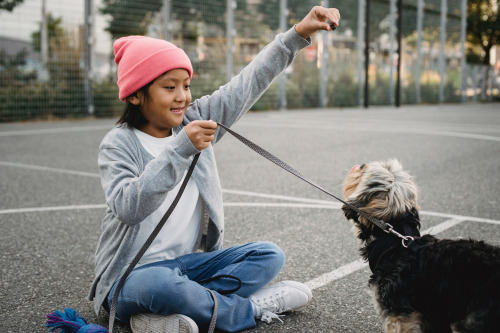
The COVID-19 Pandemic has impacted the dog training industry in a big way but training has always been an integral part of a happy dog’s everyday life. You do not need to wait for your dog to misbehave to seek professional training. Ideally, it should begin as soon as you bring your dog into your home. Training prevents unwanted behavioral issues that may arise, builds trust, and strengthens the bond between you and your dog. It’s essential to set your dog up for success by communicating with them in a language they can understand, such as hand signals and verbal cues. Windy City Paws is proud to be providing Training Walks as a new service! Check out our Training Options by clicking on this link: Training Walk
Virtual Dog Training Classes
While businesses slowly reopen, many trainers and dog-training facilities offer virtual lessons and online classes in place of in-person training. Some offer group classes at limited capacity in their facilities with their own protocols and guidelines to ensure everyone’s safety. Clarifying your training needs ahead of time, will help your trainer set up an effective behavior modification plan. Take videos of your dog’s behavior ahead of your sessions and share them with your trainer. This will give your trainer a better picture of how your dog is interacting with you, what behaviors need to be improved, and they may catch behaviors you’re missing. In most cases, you will either pre-record training sessions with your dog to be evaluated by the trainer, or sessions will be held over a live stream. You need to make enough space in your home for you and your pet to move around comfortably and to find a place for your camera where the trainer can see you clearly.
Dog Training at Home
At home, you can work on some basic training commands such as sit, down, come, stay, leave it, drop it, look at me focus training, impulsive control training, and even loose leash walking. It is always best to train your dog in a distraction-free area, then work your way outdoors once they start to master their commands. While dog training at home can be convenient, it’s best to ensure all roommates or family are on board with this decision, and can regularly make time and space for these sessions. Like deep work on any new skill, consistency is key, so interrupting sessions also interrupt your pet’s progress. Especially if you have small children, set boundaries around your dog’s training time: make playtime a reward for their hard work!
Valuable training equipment to consider using would be a clicker, various treats (some high value), and a treat pouch. Most dogs are food-motivated and are an essential tool to reward them when they do something right. A treat pouch will make your life easier when you want to reward your dog quickly. Most pouches function with a draw-string and belt clip, so you don’t have to fumble for treats in your pockets or Ziploc bags. Quickly rewarding your dog for the behavior you want is crucial since dogs have roughly 1.3 seconds to connect cause and effect. If you try to reward or correct behavior more than two seconds after the fact, they won’t know what it’s for.
A clicker is a reinforcing tool that can help get your pet’s attention. Offering treats in quick succession after the clicker sound can also reinforce associations between sound and reward. You might also use a word like “yes” or “good” that reinforces they did something right with a reward that follows. A reward can be anything from treats, toys, pettings, play, or praise.
Some training equipment options to help manage dogs that pull are front-chest lead harnesses, Easy Walk, and Freedom Harness. These options are suitable for dogs that are more reactive and challenging to control on a leash. Front-chest lead harnesses help redirect dogs by the chest and put the dog off-balance if they try to pull. The Gentle Leader (or ‘head halter’) redirects a dog’s direction by the snout while walking. Freedom Harnesses are best for large and strong dogs, as they come with both a back and chest clip for attaching two leashes. This allows you to train against pulling behavior with the chest leash while providing additional security with the back leash. Equipment and tools alone can’t train your dog, however. It’s your patience, consistency, and positive reinforcement that teaches them how to behave properly on a walk and creates positive behaviors. Should we include something here like you can partner with a professional dog walking company to reinforce your training work?
Positive Reinforcement
The one thing all reputable trainers can agree on is that positive reinforcement training is the best method for long-lasting results and a happier dog. This means rewarding behaviors you want to see and encouraging them to substitute undesirable behaviors with new ones that lead to rewards. Your dog is more likely to repeat the desired behavior you want when they feel good about what they did. Training should be fun and enjoyable for you and your dog alike.
Avoid punishment-based methods such as collar ‘corrections’ (i.e., forceful pulls on the leash) or otherwise using pain, discomfort, or intimidation to train your dog. These methods reflect an outdated view of dog training that has not held up to time and research: punitive training simply results in worse behavior in the dog and lower quality of life overall. Like with any other person, we would much rather build a relationship based on trust and support than intimidation and fear.
While we go into greater detail on disciplinary collars in our article on dog equipment, what you need to know now is that these types of collars are not intended for long-term use. If your dog no longer has an excessive pulling problem, punitive collars are unnecessary and only cause them undue discomfort. This and other disciplinary, fear-based methods will inflict more stress, fear, and possible injury in the long run, and It will only serve to make their behavior worse while breaking their trust in you. Once again, there is always a better, less invasive way of encouraging new behavior in your pet. If you find yourself stuck on how to make changes, consult a professional trainer before resorting to more punitive methods. Your dog will thank you!
Seeking a Trainer
When looking for a professional trainer, look for a highly reputable positive reinforcement trainer. Windy City Paws is proud to be providing Training Walks as a service! Check out our Training Options by clicking on this link: Training Walk
Train your dog with love, respect, trust, kindness, and use positive training methods based on up-to-date science. Hard work pays off in the end, resulting in a more happy dog and happy you!
Thank you, Arelys, for that helpful information on training during Covid-19! Windy City Paws is a Fear Free Chicago dog walker and petsitter committed to providing helpful information to Chicago dog owners through its blog.
Written for Windy City Paws by Arelys

